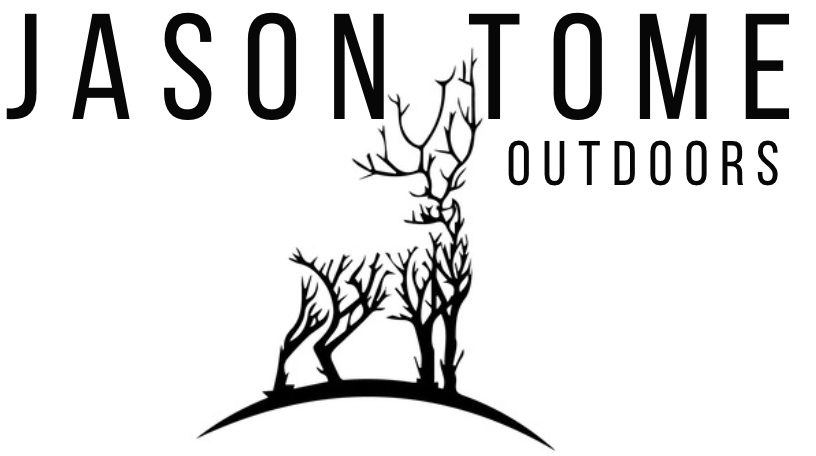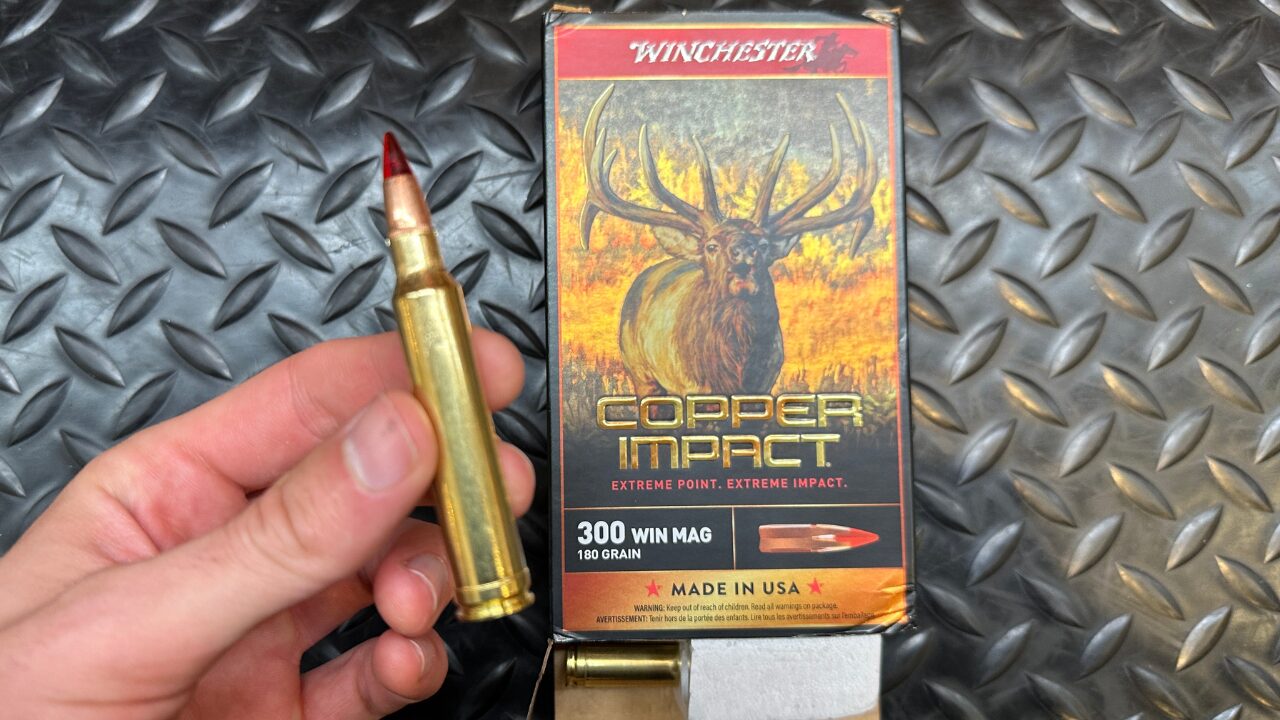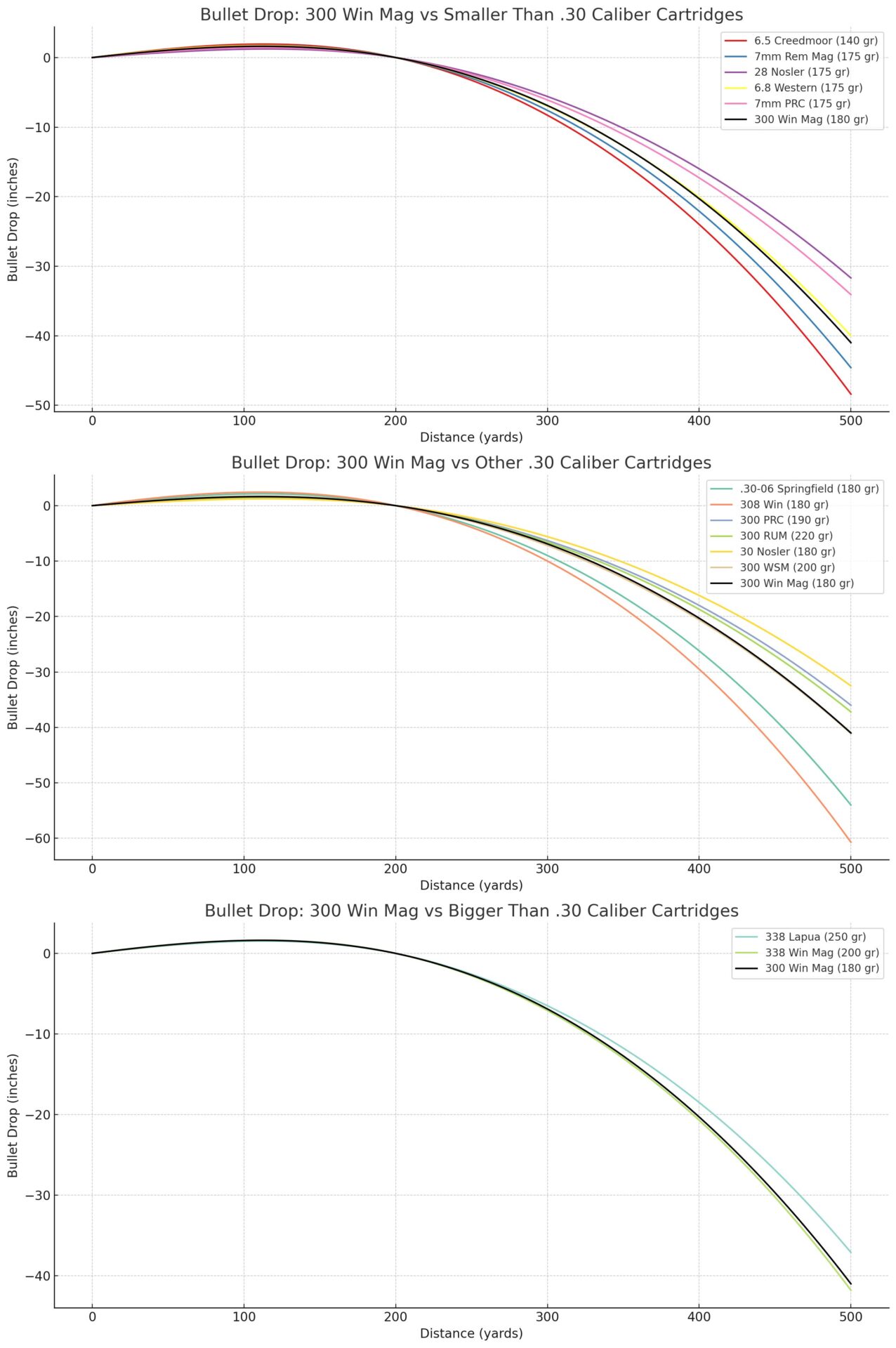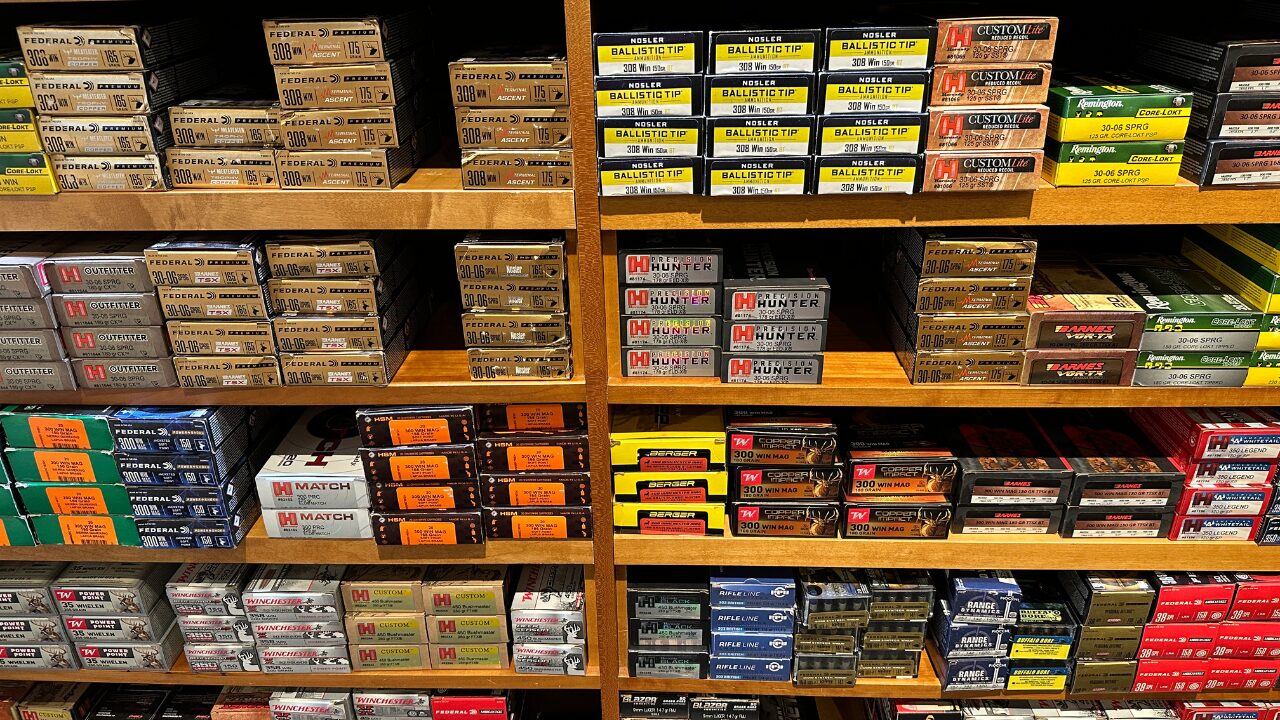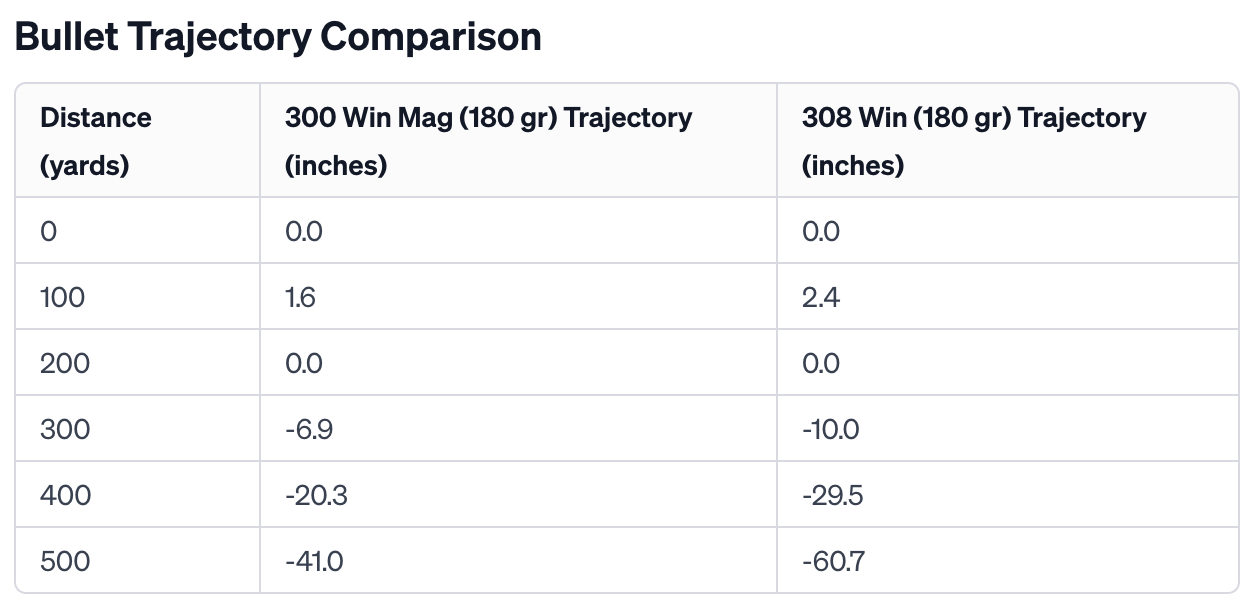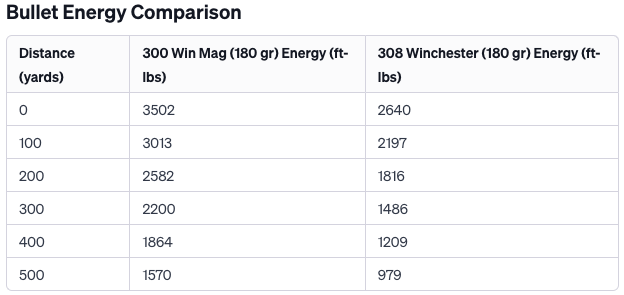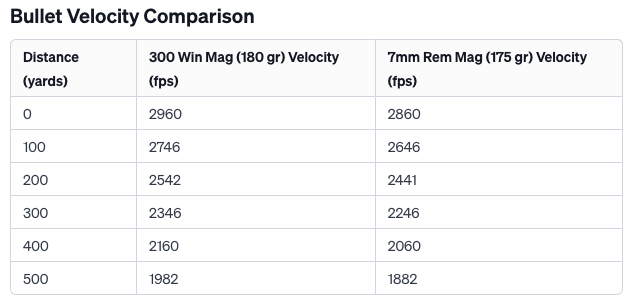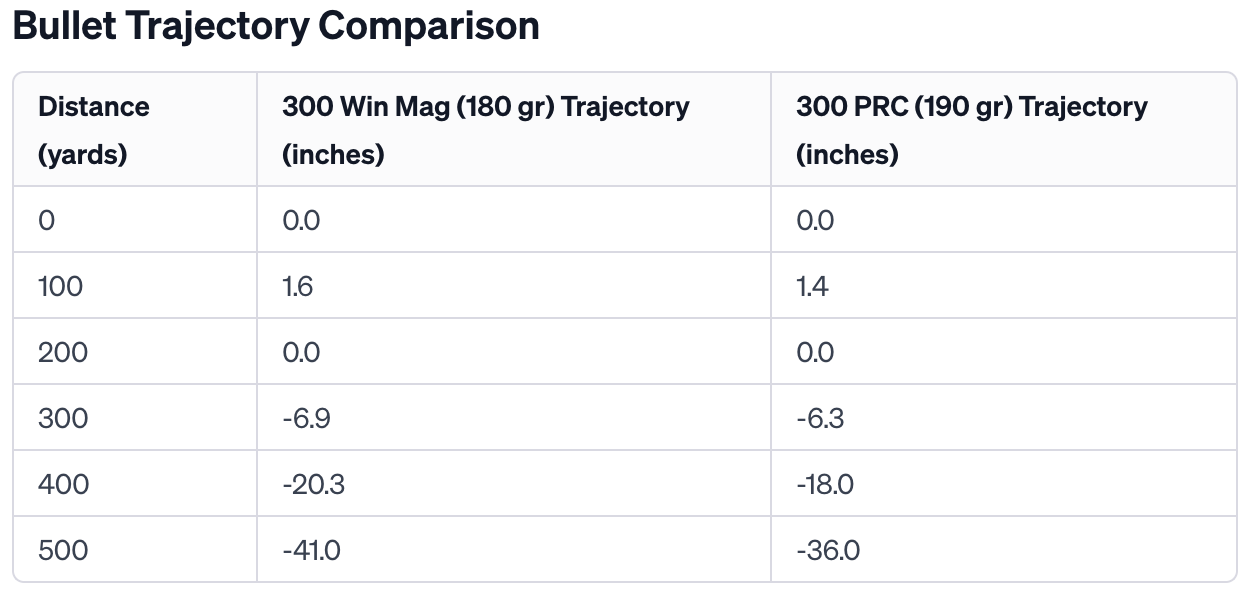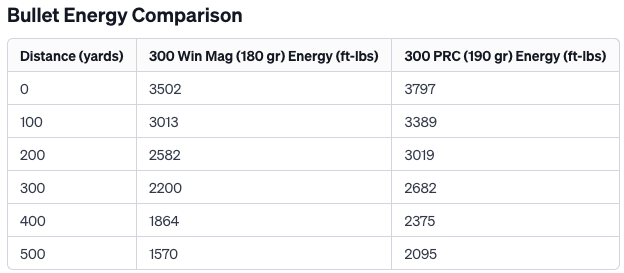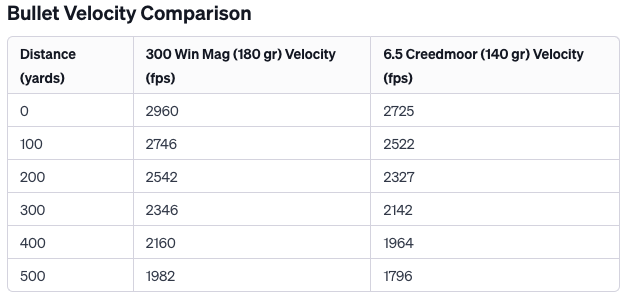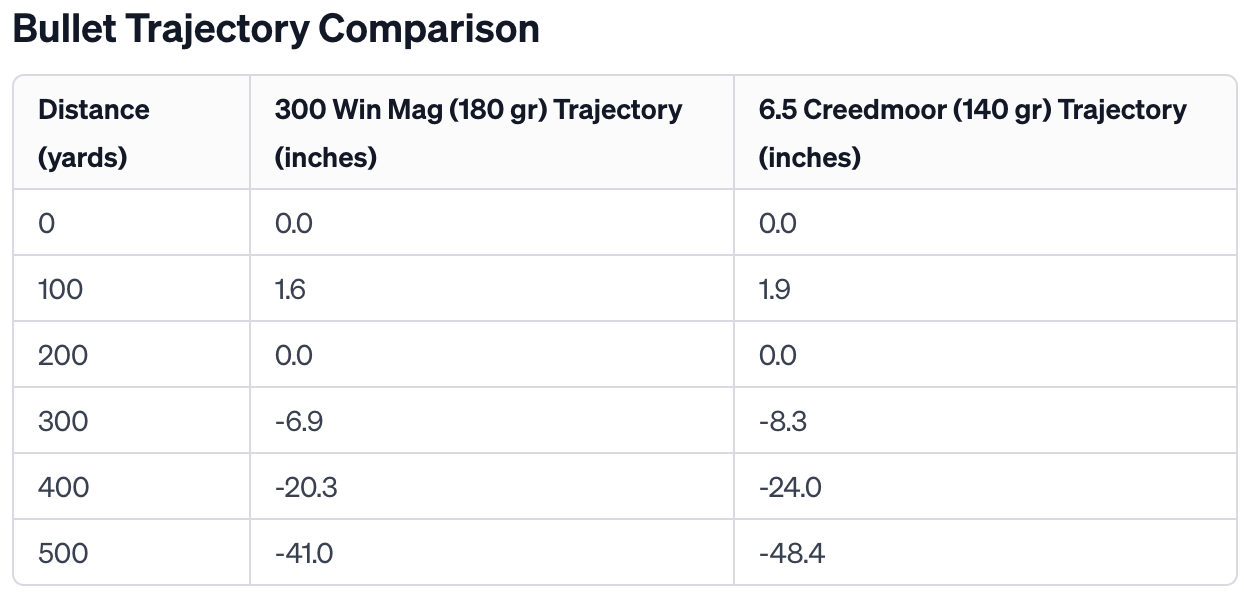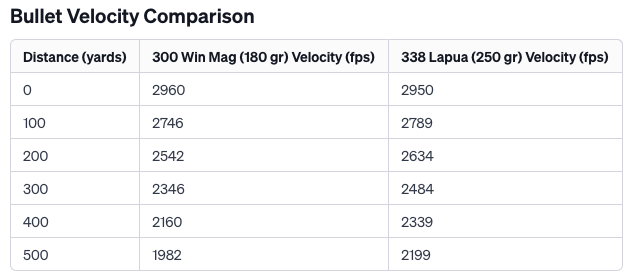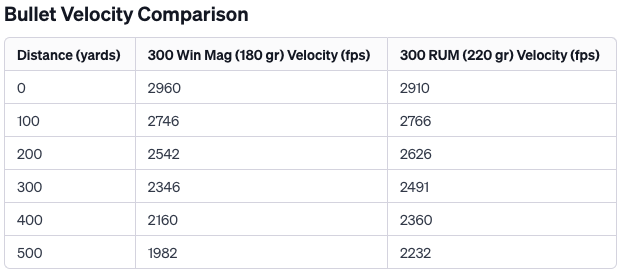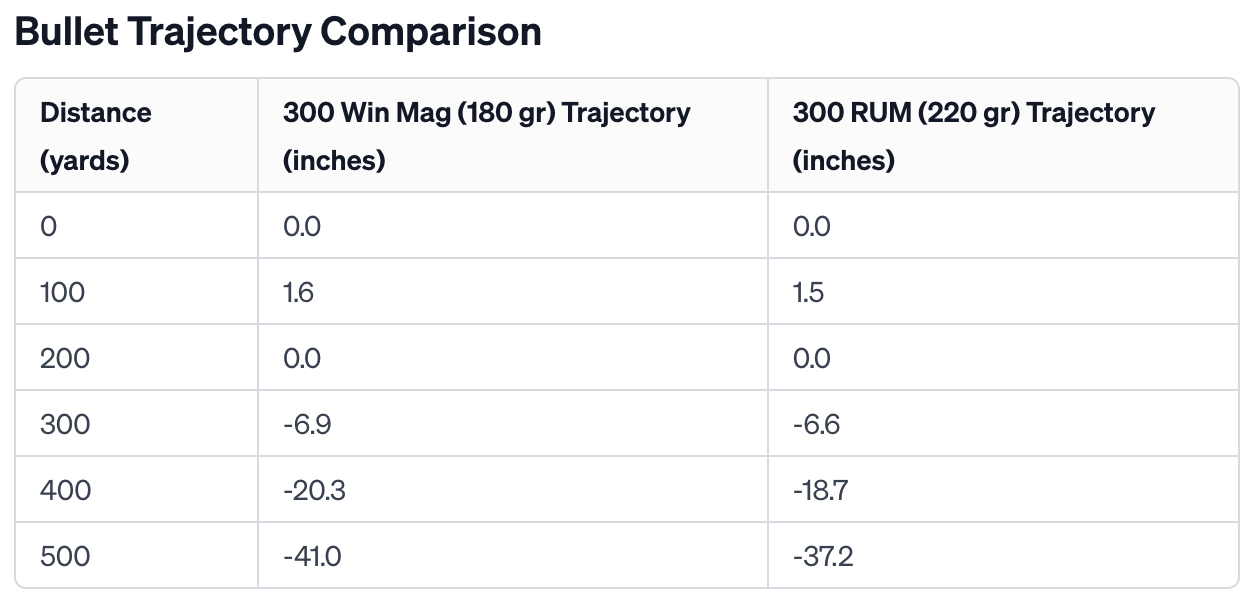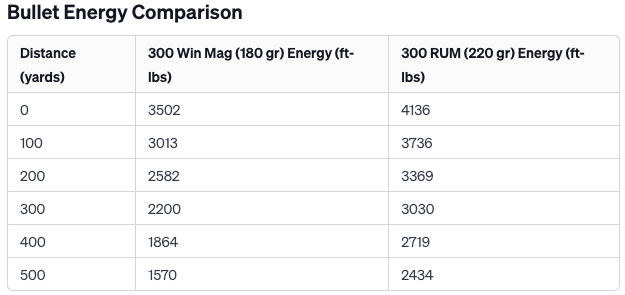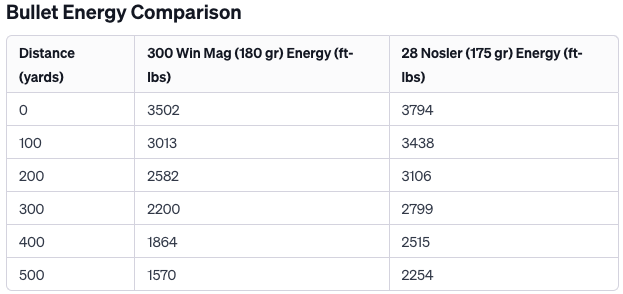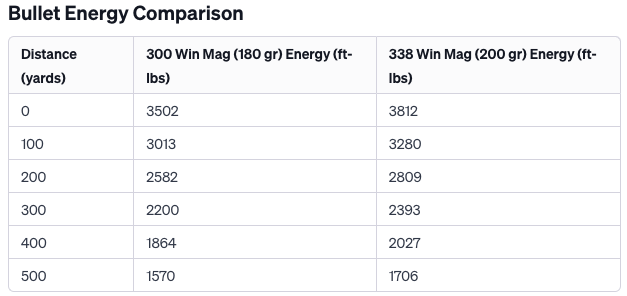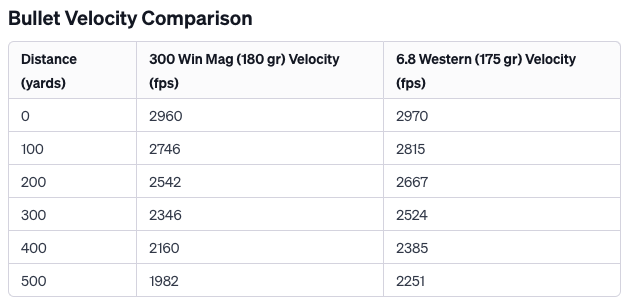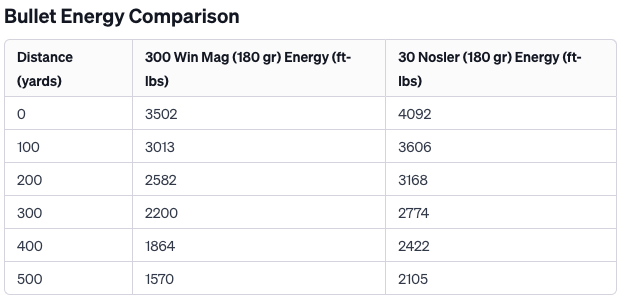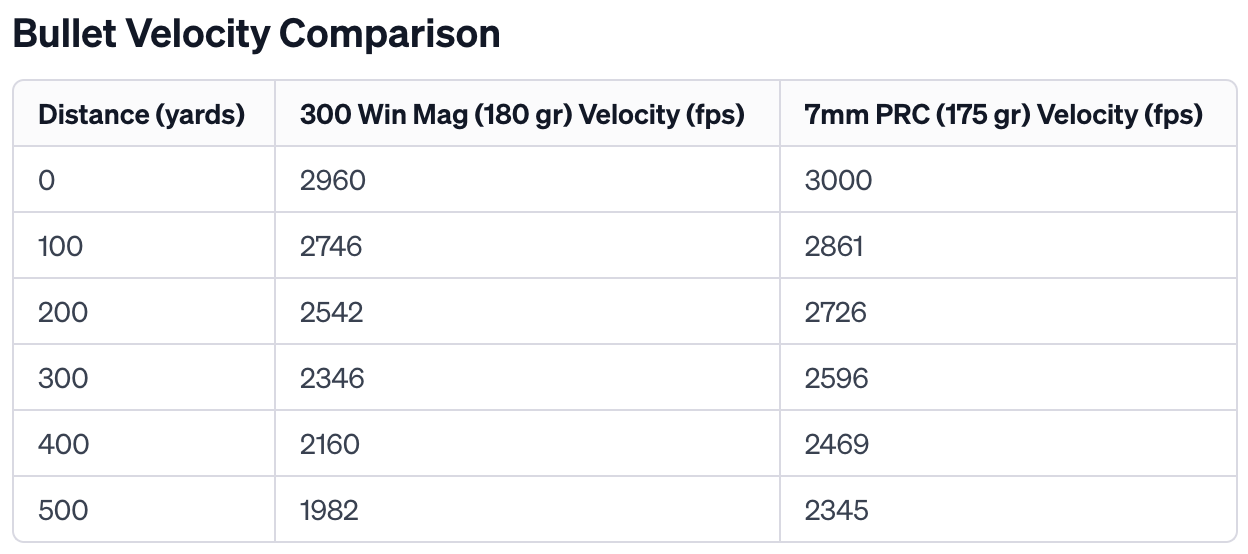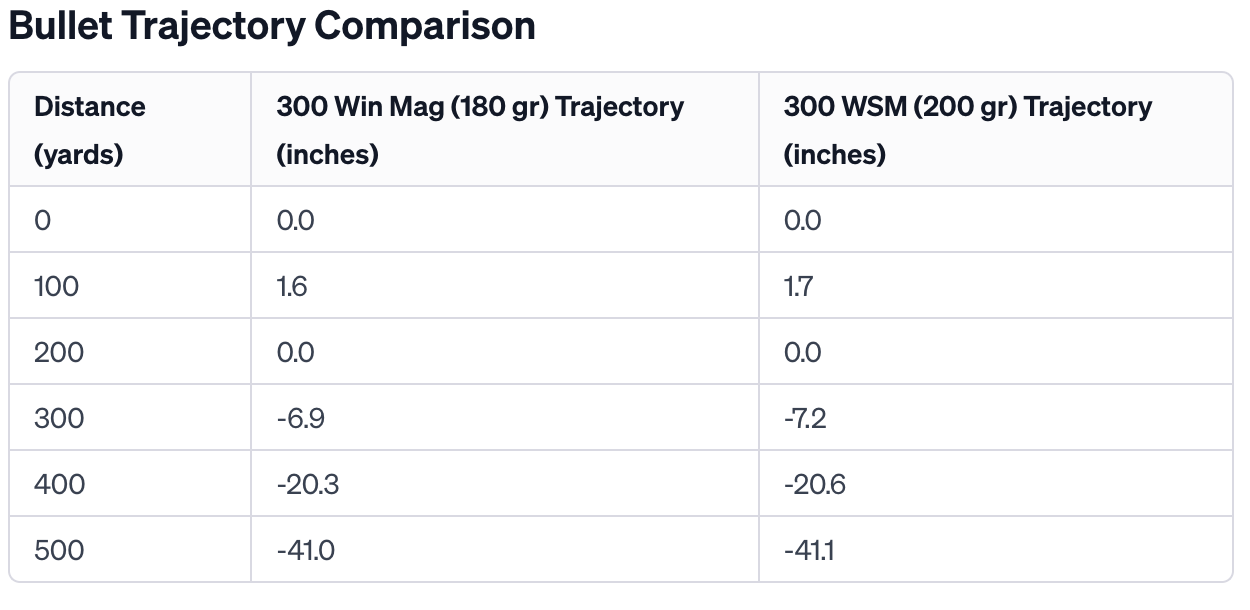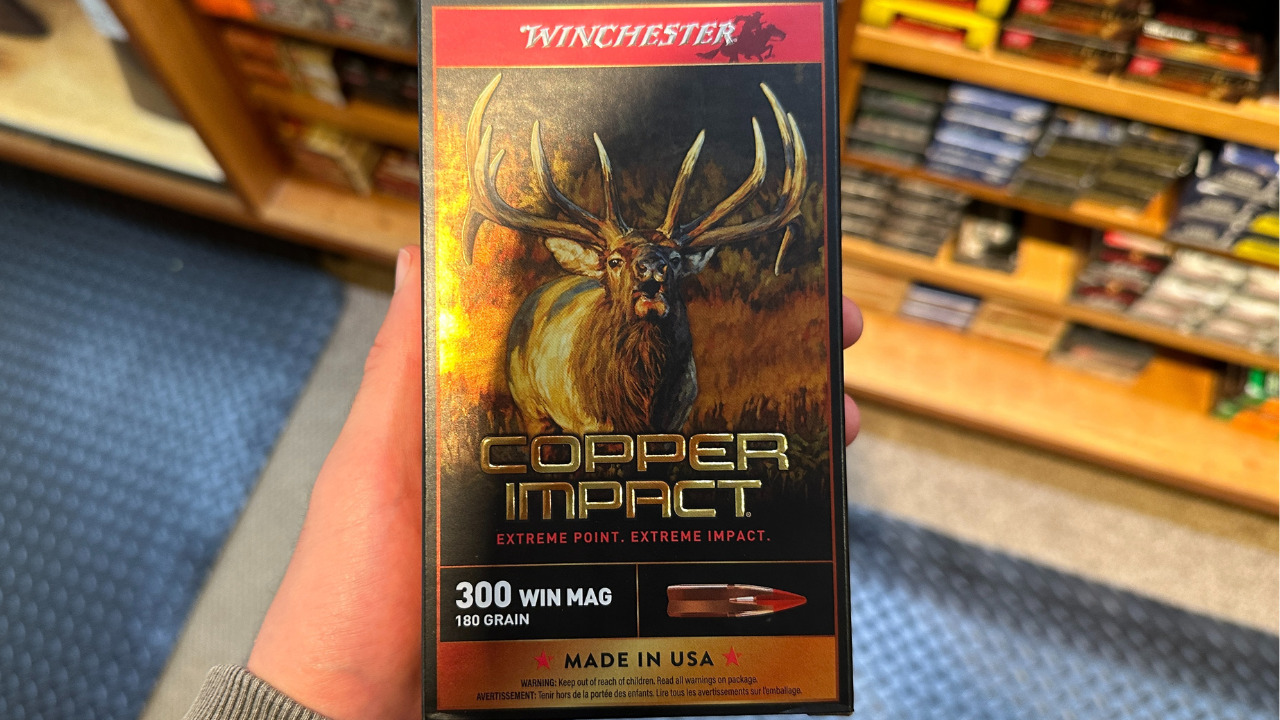Let’s explore the 300 Win Mag vs 13 other popular cartridges using ballistic tables and graphs out to 500 yards. 300 Win Mag’s velocity, trajectory, energy, wind drift, and recoil are compared to all 13 cartridges providing a clear and data-driven perspective on how the 300 Win Mag stacks up.
With new cartridges coming onto the market, it is interesting to see how this tried and true cartridge still stacks up. It’s also nice to be able to visualize how the 300 Win Mag compares to other traditional cartridges.
In this article, the 300 Win Mag is compared side-by-side with the:
- 308 Win
- 7mm Rem Mag
- 30-06 Springfield
- 300 PRC
- 6.5 Creedmoor
- 338 Lapua
- 300 RUM
- 28 Nosler
- 338 Win Mag
- 6.8 Western
- 30 Nosler
- 7mm PRC
- 300 WSM
Table of Contents
How To Use This Blog Post:
The Ballistic Graphs
I used similar grain bullets for most cartridges (175-200 gr) when possible so it would be the best apples-to-apples comparison. Some of the smaller calibers don’t make bullets that big so I used a common bullet grain for those cartridges. Some of the larger calibers in this comparison don’t make bullets that small so I also used a common bullet grain for those cartridges as well.
I also broke the graphs out into three groups, and compared the 300 Win Mag to all three:
- Smaller than 30 Caliber Group
- 30 Caliber Group
- Larger than 30 Caliber Group
This was beneficial to see the graphs, otherwise, there were too many lines on a single graph.
Keep in mind that with different bullet grains, you will get slightly different results than shown below. But you can use the information below to determine the potential of each caliber.
The Ballistic Tables
If you want a 1 on 1 comparison of each cartridge to the 300 Win Mag, you can find that in the Graph Summary (after the graphs), this is where you’ll find the ballistic tables.
Let’s jump into the graphs first because they’ll answer your broader questions fastest:
Velocity Comparison Graph: 300 Win Mag vs Popular Cartridges
Below are velocity ballistic graphs of all 14 cartridges separated into the previously mentioned three groups. The 300 Win Mag is compared in all three graphs and it is shown as a black line in all graphs.
Trajectory Comparison Graph: 300 Win Mag vs Popular Cartridges
Below are trajectory ballistic graphs of all 14 cartridges separated into the previously mentioned three groups. The 300 Win Mag is compared in all three graphs and it is shown as a black line in all graphs.
Bullet Energy Comparison Graph: 300 Win Mag vs Popular Cartridges
Below are bullet energy ballistic graphs of all 14 cartridges separated into the previously mentioned three groups. The 300 Win Mag is compared in all three graphs and it is shown as a black line in all graphs.
Wind Drift Comparison Graph: 300 Win Mag vs Popular Cartridges
Below are wind drift ballistic graphs of all 14 cartridges separated into the previously mentioned three groups. The 300 Win Mag is compared in all three graphs and it is shown as a black line in all graphs.

Recoil Comparison Graph: 300 Win Mag vs Popular Cartridges
Below is a recoil graph that is not separated into the previously mentioned three groups, instead it contains all of the cartridges in this one graph. The red dotted line shows the recoil energy of the 300 Win Mag compared to the other popular cartridges. Recoil velocity is also shown for each cartridge.

Ballistic Tables: 300 Win Mag vs Popular Cartridges
300 Win Mag vs 308 Winchester
In the world of long-range hunting and shooting, the comparison between the 300 Winchester Magnum (300 Win Mag) and the 308 Winchester (308 Win) is a topic of much interest. Let’s delve into a detailed analysis of these two cartridges, examining their performance in terms of bullet velocity, trajectory, energy, wind drift, and recoil.
Velocity
- 300 Win Mag (180 gr): Starts with a muzzle velocity of 2960 feet per second (fps), which is significantly higher than the 308 Win. This high initial speed is maintained over greater distances, providing the 300 Win Mag with superior long-range capabilities.
- 308 Winchester (180 gr): Begins at a lower velocity of 2570 fps. The velocity of the 308 slows at about the same rate as the 300 Win Mag, there is about a 400 fps difference in speed from 0 to 500 yards.
Trajectory
- 300 Win Mag (180 gr): Known for its flatter trajectory, the 300 Win Mag maintains a more consistent path over longer distances.
- 308 Winchester (180 gr): Exhibits a more pronounced bullet drop, especially evident at ranges beyond 300 yards. This necessitates greater compensation for bullet drop when engaging distant targets, which can be challenging for long-range precision hunting and shooting.
Energy
- 300 Win Mag (180 gr): Delivers higher energy throughout its flight path, starting from a superior muzzle energy of 3502 ft-lbs. This high energy translates to greater stopping power and effectiveness on larger game, as well as improved terminal ballistics at extended ranges.
- 308 Winchester (180 gr): Starts with 2640 ft-lbs of energy out of the muzzle, which is almost 1000-ft lbs difference. While still effective for large-sized game, it falls short in terms of stopping power compared to the 300 Win Mag, especially at long distances.
Wind Drift
- 300 Win Mag (180 gr): The cartridge’s higher velocity results in less wind drift, making it more resilient to crosswinds. This aspect is crucial in long-range hunting and shooting, where even slight wind variations can significantly impact the bullet’s path.
- 308 Winchester (180 gr): More susceptible to wind drift due to its lower velocity and ballistic coefficient. Shooters using the 308 Win must account for greater windage adjustments, especially under windy conditions and at longer ranges. There is about 10 inches of difference in wind drift between the two cartridges at 500 yards.

Recoil
- 300 Win Mag (180 gr): Notably, it has a higher recoil (35.08 ft-lbs) compared to the 308 Winchester.
- 308 Winchester (180 gr): Offers WAY better recoil (19.77 ft-lbs), about 44% less recoil. The 308 Winchester has the second-best recoil of all calibers on this list.

In summary, the 300 Win Mag offers superior performance in terms of velocity, trajectory, energy, and resistance to wind drift, making it an excellent choice for long-range shooting and hunting big game. However, this comes at the cost of increased recoil. The 308 Winchester, while not matching the long-range capabilities of the 300 Win Mag, offers a more comfortable shooting experience with less recoil, making it suitable for a wider range of hunters and shooters.
300 Win Mag vs 7mm Rem Mag
The .300 Winchester Magnum (300 Win Mag) and the 7mm Remington Magnum (7mm Rem Mag) are both popular choices among long-range shooters and hunters, each offering unique ballistic characteristics. Let’s compare the bullet velocity, trajectory, energy, wind drift, and recoil of these cartridges.
Velocity
- 300 Win Mag (180 gr): The 300 Win Mag is superior to the 7mm Rem Mag when it comes to velocity, but not by much. It maintains exactly 100 fps faster velocity from 0-500 yards. It starts off with a high muzzle velocity of 2960 fps
- 7mm Rem Mag (175 gr): The 7mm Rem Mag also exhibits high muzzle velocity (2860 fps). Although slightly lower than the 300 Win Mag, it’s still a fast cartridge.
Trajectory
- 300 Win Mag (180 gr): Known for its flat trajectory, the 300 Win Mag is less affected by gravity over distance. This characteristic contributes to easier shot placement and less need for elevation compensation at extended ranges.
- 7mm Rem Mag (175 gr): Also offers a flat trajectory but has 3.6 inches more drop at 500 yards, this is a negligible difference. The 7mm Rem Mag is often praised for its long-range capabilities, and while it might have slightly more drop than the 300 Win Mag, it’s still an excellent choice for long-range hunting and shooting.
Energy
- 300 Win Mag (180 gr): Delivers impressive energy, with 3502 ft-lbs at the muzzle and 1570 ft-lbs at 500 yards.
- 7mm Rem Mag (175 gr): This cartridge, with less energy from 0-500 yards, its close to the 300 Win Mag. It has 3178 ft-lbs at the muzzle and 1377 ft-lbs at 500 yards. It has about 200 ft-lbs lower in energy than the 300 Win Mag from 0-500 yards.
Wind Drift
- 300 Win Mag (180 gr): The 300 Win Mag again just barely beats the 7mm Rem Mag in this category. There is almost no difference, at 500 yards the 300 Win Mag will have 20-inches of wind drift with a 10 mph crosswind.
- 7mm Rem Mag (175 gr): This cartridge has 21.4-inches of wind drift at 500 yards (only 1.4 inches more than the 300 Win Mag). This means you will virtually not be able to tell the difference, especially within 500 yards.
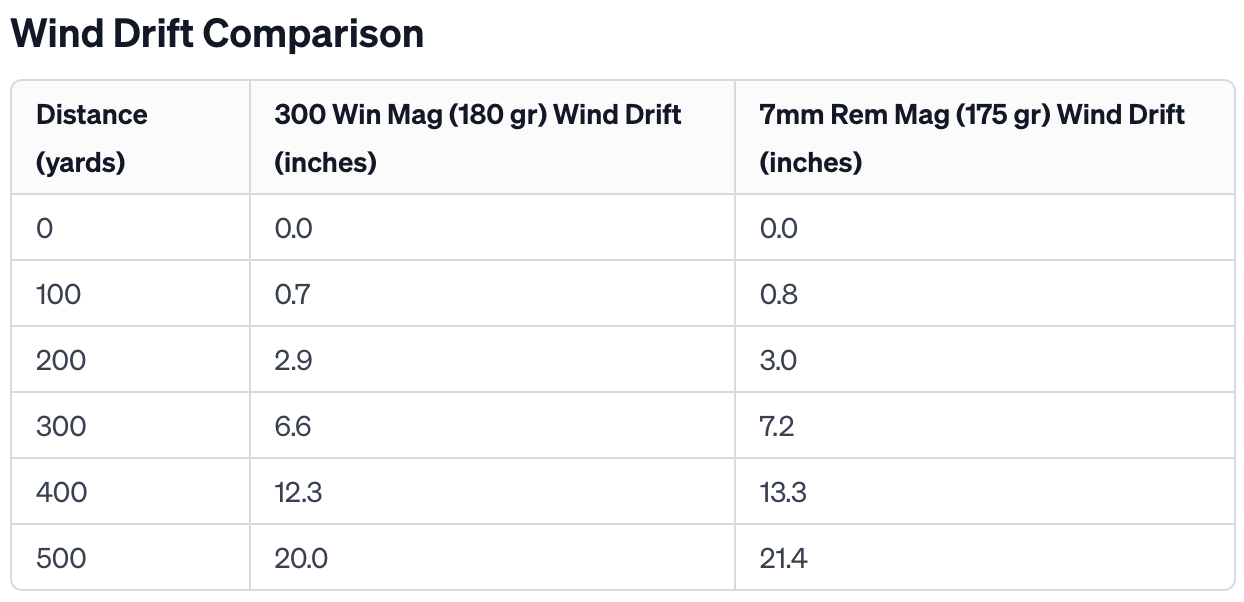
Recoil
- 300 Win Mag (180 gr): It has higher recoil (35.08 ft-lbs) compared to the 7mm Rem Mag. The question to ask would be; is the extra recoil worth the marginal difference in performance to you?
- 7mm Rem Mag (175 gr): Milder recoil (28.69 ft-lbs) compared to the 300 Win Mag. Although its performance is slightly worse than the 300 Win Mag, its recoil is 6.39 ft-lbs lighter by 18.7%, which is a lot.

In conclusion, both the 300 Win Mag and the 7mm Rem Mag are outstanding choices for long-range hunting and shooting. The 300 Win Mag leads in velocity, energy, and wind drift resistance. However, the fast, smaller diameter bullet of the 7mm Rem Mag, with its milder recoil, offers a balance of power and comfort, suitable to hunt anything the 300 Win Mag is capable of.
300 Win Mag vs 30-06 Springfield
When comparing two legendary cartridges like the .300 Winchester Magnum (300 Win Mag) and the .30-06 Springfield, there’s a rich history and a wealth of ballistic data to consider. Both cartridges have proven their worth in various shooting disciplines, but how do they stack up against each other? Let’s examine their performance in terms of bullet velocity, trajectory, energy, wind drift, and recoil. You might like my 30-06 vs 9 Most Popular Rifle Cartridges (with Ballistic Graphs) article.
Velocity
- 300 Win Mag (180 gr): Boasts a starting muzzle velocity of around 2960 fps, which gives it an edge in maintaining speed over longer distances. This high velocity is crucial for reducing bullet drop and time to target, especially in long-range shooting scenarios. The 300 Win Mag maintains about a 300 fps advantage over the 30-06 from 0-500 yards.
- 30-06 Springfield (180 gr): Typically fires at a lower velocity, around 2700 fps. While this is still respectable, the lower velocity means the bullet will take longer to reach the target and will drop more over the same distance.
Trajectory
- 300 Win Mag (180 gr): Offers a flatter trajectory thanks to its higher velocity and ballistic efficiency. This advantage becomes more apparent at ranges beyond 300 yards, where the trajectory remains more consistent, making long-range shooting more predictable.
- 30-06 Springfield (180 gr): Exhibits more bullet drop at extended ranges, requiring more elevation adjustment from the shooter. While still an effective cartridge at long ranges, it demands more calculation for accurate shot placement.
Energy
- 300 Win Mag (180 gr): Delivers superior energy on impact, starting with higher muzzle energy (3502 ft-lbs) and maintaining it over longer distances. This high energy transfer makes the 300 Win Mag particularly effective for larger game hunting and in situations where stopping power is paramount. The 300 Win Mag has about 500 ft-lbs more energy from 0-500 yards, which is a big difference.
- 30-06 Springfield (180 gr): Produces good energy levels (2913- ft-lbs at the muzzle) but falls short of the 300 Win Mag, especially at longer ranges. It’s still a very capable cartridge for medium to large game but might not be as effective for the largest game or in long-range hunting scenarios.
Wind Drift
- 300 Win Mag (180 gr): Shows better resistance to wind drift, a byproduct of its higher velocity and advanced bullet design. At 500 yards the 300 Win Mag has 20-inches of deflection.
- 30-06 Springfield (180 gr): More affected by wind, requiring the shooter to compensate more for windage at longer distances. Its slower velocity and ballistic profile make it more susceptible to wind drift compared to the 300 Win Mag. That said, there’s not much of a difference until you’re shooting over 300 yards. At 500 Yards the 30-06 has 27-inches of wind deflection.

Recoil
- 300 Win Mag (180 gr): The recoil energy is 35.08 ft-lbs which is notably higher recoil than the 30-06 Springfield.
- 30-06 Springfield (180 gr): Offers moderate recoil (26.50 ft-lbs), almost 10 ft-lbs lighter or about 24.5% less recoil which is substantial.

In summary, the 300 Win Mag surpasses the 30-06 Springfield in terms of velocity, trajectory, energy, and wind drift resistance, making it a superior choice for long-range hunting and shooting, especially for big game. However, its significant recoil can be a drawback for some shooters. On the other hand, the 30-06 Springfield, with its more manageable recoil and still respectable ballistic performance, remains a versatile and popular choice among hunters and shooters.
300 Win Mag vs 300 PRC
The .300 Winchester Magnum (300 Win Mag) and the .300 Precision Rifle Cartridge (300 PRC) are two high-performance cartridges that have garnered attention in the shooting world for their impressive long-range capabilities. Let’s compare these two .300 caliber giants across the various ballistic parameters to see how they measure up.
Velocity
- 300 Win Mag (180 gr): Its high initial velocity starts around 2960 fps. This speed is a significant factor in the cartridge’s long-range performance, allowing the bullet to travel faster and hit the target more quickly.
- 300 PRC (190 gr): Boasts a faster (3000 fps) but very comparable muzzle velocity to the 300 Win Mag. It’s designed to maintain velocity over long distances, losing less energy than the 300 Win Mag.
Trajectory
- 300 Win Mag (180 gr): Offers a relatively flat trajectory, thanks to its high velocity and efficient bullet design. This results in less bullet drop at longer ranges, which is advantageous for precision shooting. The 300 Win Mag has about 5-inches more drop at 500 yards, not a significant difference, but notable.
- 300 PRC (190 gr): Engineered specifically for long-range shooting, it provides a very flat trajectory. Its advanced bullet design and optimized case capacity allow for efficient flight dynamics, exceeding the trajectory performance of the 300 Win Mag.
Energy
- 300 Win Mag (180 gr): The 3502 ft-lbs, although a lot of muzzle energy is notably less than the 300 PRC and does not retain its energy as well at distance, with only 1570 ft-lbs at 500 yards, a 500 ft-lbs difference.
- 300 PRC (190 gr): Designed to maximize ballistic potential, it also produces high downrange energy. The 300 PRC’s ability to shoot heavier, high-BC bullets efficiently gives it an edge in energy retention, especially at extreme ranges. It has a muzzle energy of 3797 ft-lbs and maintains 2095 ft-lbs out to 500 yards.
Wind Drift
- 300 Win Mag (180 gr): Exhibits good resistance to wind drift, but not as good at the 300 PRC. There is 20-inches of wind drift at 500 yards.
- 300 PRC (190 gr): Its superior aerodynamic efficiency gives it an advantage in wind drift resistance. The 300 PRC’s ability to use very aerodynamic bullets means it can be more predictable and accurate in windy conditions compared to the 300 Win Mag. There is 14.2 inches of wind drift at 500 yards, almost a 6-inch difference.
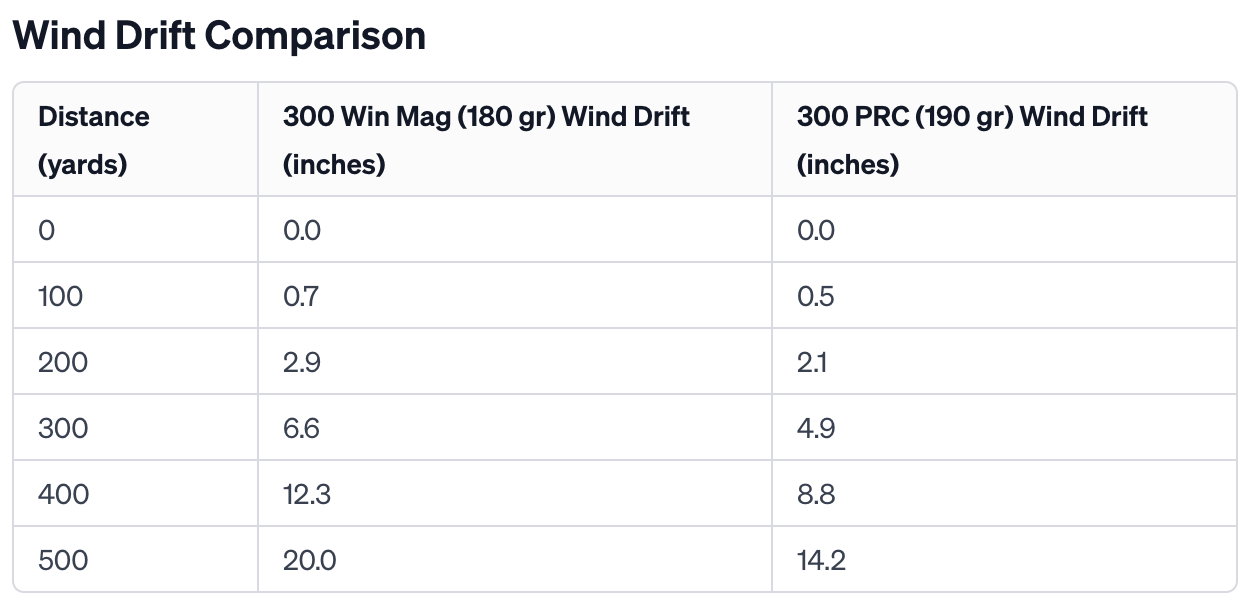
Recoil
- 300 Win Mag (180 gr): The 300 Win Mag has a lot of recoil (35.08 ft-lbs), but not as much as the 300 PRC.
- 300 PRC (190 gr): Has significant recoil (39.82 ft-lbs), which is 13.5% more recoil. Due to its design for shooting heavy, high-BC bullets, the recoil can be stout, requiring proper shooting technique and recoil management strategies. Is the extra performance over the 300 Win Mag worth it for you?

In conclusion, both the 300 Win Mag and 300 PRC are exceptional cartridges. Both cartridges deliver powerful energy and flat trajectories but come with substantial recoil. The 300 PRC outperforms the 300 Win Mag in velocity, trajectory, energy, and wind drift but it comes at the cost of more recoil.
300 Win Mag vs 6.5 Creedmoor
In the realm of long-range shooting, the comparison between the .300 Winchester Magnum (300 Win Mag) and the 6.5 Creedmoor often sparks interest due to their contrasting characteristics. The 300 Win Mag is known for its raw power and long-range capabilities, while the 6.5 Creedmoor has gained immense popularity for its precision and shooter-friendly attributes. Let’s delve into their ballistic performances across various aspects.
Velocity
- 300 Win Mag (180 gr): Boasts a high muzzle velocity around 2960 fps. This superior speed and bigger bullet aids in longer effective range and better performance at long distances. At 500 yards the 300 Win Mag maintains 1982 fps.
- 6.5 Creedmoor (140 gr): Typically offers a lower velocity, usually around 2725 fps for a 140 gr bullet. While it may not match the raw speed of the 300 Win Mag, it compensates with excellent ballistic coefficients, which helps maintain velocity over longer distances. For example, at the muzzle, there is a 235 fps difference but the 6.5 Creedmoor closes the distance at longer ranges. At 500 Yards the 6.5 Creedmoor is 1796 fps, which is only a 186 fps difference.
Trajectory
- 300 Win Mag (180 gr): Exhibits a flatter trajectory, especially noticeable at ranges beyond 300 yards. This flatness aids in more straightforward shot placement with less need for elevation adjustments. At 500 yards there are 41-inches of bullet drop.
- 6.5 Creedmoor (140 gr): Known for its efficient trajectory, it offers a relatively flat path, thanks to its high ballistic coefficients. However, it will have slightly more drop than the 300 Win Mag at extreme ranges. At 500 yards, there are 48.4-inches of bullet drop, so 7.4-inches of difference. 300 yards and under, there’s only about an inch or less in difference.
Energy
- 300 Win Mag (180 gr): Delivers substantial energy, 3502 ft-lbs at the muzzle, and maintains its energy pretty well at distance with 1570 ft-lbs at 500 yards.
- 6.5 Creedmoor (140 gr): Although the velocity and trajectory of the 6.5 is near the 300 Win Mag, the bullet energy is where the 300 Win Mag pulls ahead in performance. At the muzzle, the 6.5 Creedmoor has 2308 ft-lbs of energy (1194 ft-lbs difference). That said, the 6.5 closes the gap at longer ranges with 1003 ft-lbs at 500 yards (567 ft-lbs difference). Although the 300 Win Mag is still significantly more powerful at 500 yards, the 6.5 Creedmoor closes the gap by 47% compared to the muzzle energy.
Wind Drift
- 300 Win Mag (180 gr): Exhibits good resistance to wind drift, but only slightly better than the 6.5 Creedmoor. At 300 Yards there is 6.6-inches drift and at 500 yards there is 20-inches of drift.
- 6.5 Creedmoor (140 gr): Excels in wind drift performance, as its high ballistic coefficient bullets cut through the wind effectively. This trait is one of the key reasons for its popularity in long-range precision shooting. It competes closely with the 300 Win Mag, but the 300 Win Mag does have less wind drift overall. For example, at 300 yards there is 7.5-inches (1.1-inches difference) of drift at 500 yards there is 22.5-inches of wind drift (2.5-inches of difference).

Recoil
- 300 Win Mag (180 gr): The 300 Win Mag has a lot of recoil (35.08 ft-lbs), which is significantly more than the 6.5 Creedmoor.
- 6.5 Creedmoor (140 gr): This cartridge has the least recoil of all rifles Renowned for its mild recoil (15.49 ft-lbs), which is 56% less recoil than the 300 Win Mag.

In conclusion, the 300 Win Mag and the 6.5 Creedmoor cater to different needs in the shooting world. The 300 Win Mag stands out for its power and extended-range capabilities, making it a go-to for large game hunting and long-range shooting. The 6.5 Creedmoor, on the other hand, is celebrated for its accuracy, efficient ballistics, and shooter-friendly nature, making it a favorite among precision shooters and those looking for a more manageable recoil profile.
300 Win Mag vs 338 Lapua Magnum
The .300 Winchester Magnum (300 Win Mag) and the .338 Lapua Magnum (338 Lapua) are two of the most formidable cartridges in long-range shooting. Both have a storied history and a reputation for exceptional performance, but they serve slightly different roles in the world of precision shooting and hunting. Let’s compare these two powerhouses across key ballistic aspects.
Velocity
- 300 Win Mag (180 gr): Known for a high muzzle velocity of about 2960 fps with a 180 gr bullet, it maintains speed effectively over long distances, which is crucial for long-range accuracy and energy retention.
- 338 Lapua (250 gr): With a 250 gr bullet, the 338 Lapua almost has the same muzzle velocity compared to the 300 Win Mag (2950 fps), but its heavier bullet retains velocity better.
Trajectory
- 300 Win Mag (180 gr): The 180 gr 300 Win Mag offers a flat trajectory, it is close to the big 250 gr 338 Lapula cartridge, but is not quite as flat.
- 338 Lapua (250 gr): Despite being a bigger and much heavier bullet, the 338 Lapua still has a flatter trajectory but not by much. You only notice a difference at about 500 yards. At 300 yards the 338 Lapua has 2-inches less drop, At 500 yards it has 5-inches less drop.
Energy
- 300 Win Mag (180 gr): Delivers substantial energy, 3502 ft-lbs at the muzzle, and maintains its energy pretty well at distance with 1570 ft-lbs at 500 yards. It does not deal nearly the same energy as the 338 Lapua Magnum, but it does close the distance by 200 ft-lbs at 500 yards.
- 338 Lapua (250 gr): Although the 300 Win Mag has substantial energy, its nothing compared to the 338 Lapua Magnum. The Lapua has exceptionally high bullet energy – 4830 ft-lbs at the muzzle which is 1328 ft-lbs more than the 300 Win Mag. Not only that, but it maintains 2685 ft-lbs at 500 yards, 1115 ft-lbs more than the 300 Win Mag. This is largely due to the cartridge being bigger in every way.
Wind Drift
- 300 Win Mag (180 gr): Demonstrates good resistance to wind drift, but not quite as good as the 338 Lapua.
- 338 Lapua (250 gr): Outstanding performance in wind drift due to its high ballistic coefficient bullets. This cartridge is known for its ability to remain stable and accurate in challenging wind conditions, often outperforming the 300 Win Mag at very long ranges. At 500 yards it has 5.7-inches less wind drift than the 300 Win Mag.

Recoil
- 300 Win Mag (180 gr): The 300 Win Mag has 35.08 ft-lbs of recoil, which is significant, but not nearly as much as the 338 Lapua.
- 338 Lapua (250 gr): This cartridge has 65.47 ft-lbs of recoil, meaning it has 87% more recoil than the 300 Win Mag. It has the most powerful recoil of any cartridge in this comparison. This substantial recoil requires careful management and can be challenging, particularly for less experienced shooters.

In summary, while both the 300 Win Mag and 338 Lapua offer remarkable long-range capabilities, they excel in different scenarios. The 300 Win Mag provides an excellent balance of velocity, trajectory, and energy with manageable recoil, making it suitable for a broad range of long-range hunting and shooting applications. The 338 Lapua, with its superior energy delivery and wind drift performance, is ideal for the most challenging long-range shooting scenarios, including large game hunting and precision shooting at extreme distances.
300 Win Mag vs 300 RUM
The .300 Winchester Magnum (300 Win Mag) and the .300 Remington Ultra Magnum (300 RUM) are both highly respected in the realm of long-range shooting and hunting. While they share the .300 caliber designation, their performances have distinct characteristics. Let’s delve into a detailed comparison of these two cartridges across bullet velocity, trajectory, energy, wind drift, and recoil.
Velocity
- 300 Win Mag (180 gr): Has an impressive muzzle velocity of 2960 fps, which is faster than the 300 RUM. That said, at around 75 yards the 300 RUM surpasses the velocity of the 300 Win Mag.
- 300 RUM (220 gr): Can push a 220-grain bullet just about as fast as the 180 gr 300 Win Mag with a muzzle velocity of 2910 fps. Past 75 yards the 300 RUM has an increasingly more velocity.
Trajectory
- 300 Win Mag (180 gr): Provides a flat trajectory that competes with the 300 RUM but is not as quite as flat. At 500 yards, it has 41-inches of bullet drop.
- 300 RUM (220 gr): Even with its heavier bullet the 300 RUM has an even flatter trajectory than the 300 Win Mag. At 500 yards, it as 37.2-inches of bullet drop, a difference of only 3.8-inches.
Energy
- 300 Win Mag (180 gr): Delivers substantial energy, 3502 ft-lbs at the muzzle, and maintains its energy pretty well at distance with 1570 ft-lbs at 500 yards. Even so, it does not have nearly the same energy as the 300 RUM nor does it maintain its energy as well.
- 300 RUM (220 gr): Offers even higher energy with a heavier bullet weight with similar velocities. At the muzzle, the 300 RUM is producing 4136 ft-lbs of energy which is 634 more ft-lbs than the 300 Win Mag. Additionally, the 300 RUM maintains its energy better with 864 more ft-lbs at 500 yards. At 500 yards it has 2434 ft-lbs of energy, making it the most powerful 30 caliber cartridge in this comparison.
Wind Drift
- 300 Win Mag (180 gr): Exhibits good resistance to wind drift, but not as good as the 300 RUM. At 500 yards the 300 Win Mag has 20-inches of drift.
- 300 RUM (220 gr): The higher velocity and potential for heavier, high-BC bullets give the 300 RUM an edge in wind drift resistance. It can maintain a more consistent path in windy conditions, a significant advantage in long-range precision shooting. At 500 yards the 300 RUM only has 12.9-inches of drift, a 7.1-inch difference. The 300 RUM has the least wind drift of any of the 30 calibers in this comparison.
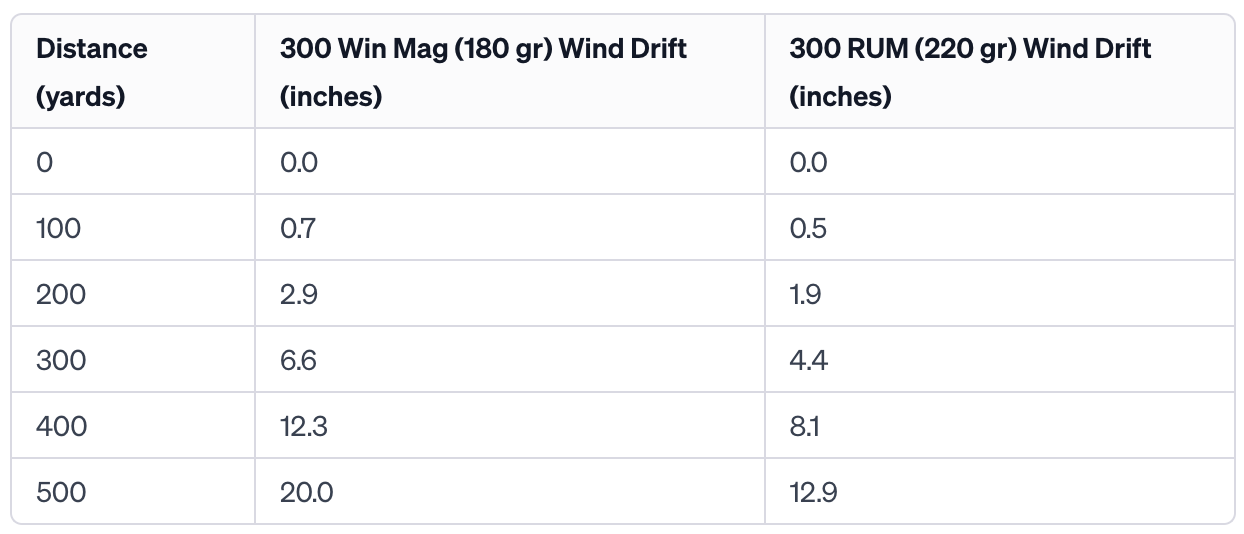
Recoil
- 300 Win Mag (180 gr): The 300 Win Mag has 35.08 ft-lbs of recoil, which is significant, but it’s much less than the 300 RUM.
- 300 RUM (220 gr): Has a reputation for recoil, with 57.24 ft-lbs of it. It has 63.2% more recoil than the 300 Win Mag.

In conclusion, while both the 300 Win Mag and 300 RUM offer exceptional long-range performance, they cater to slightly different needs. The 300 Win Mag strikes a balance between power, trajectory, and manageable recoil, making it suitable for a wide range of hunting and shooting applications. The 300 RUM, with its superior velocity, flatter trajectory, and higher energy, is ideal for challenging long-range shooting scenarios and for hunters who require maximum downrange performance. However, its significant recoil can be a consideration for many shooters.
300 Win Mag vs 28 Nosler
The .300 Winchester Magnum (300 Win Mag) and the 28 Nosler are both celebrated for their long-range shooting capabilities, each offering unique advantages. The 300 Win Mag is renowned for its versatility and power, while the 28 Nosler has gained recognition for its high velocity and flat trajectory. Let’s compare these two cartridges in detail across key ballistic aspects.
Velocity
- 300 Win Mag (180 gr): This cartridge typically boasts a muzzle velocity of around 2960 fps.
- 28 Nosler (175 gr): Known for its impressively high muzzle velocity, exceeding the 300 Win Mag, with speeds around 3125 fps for a 175 gr bullet. This increased velocity aids in a longer effective range and improved terminal ballistics.
Trajectory
- 300 Win Mag (180 gr): Provides a flat trajectory, but not as flat as the 28 Nosler. At 500 yards it has 41-inches of drop.
- 28 Nosler (175 gr): Offers the flattest trajectory of any cartridge in this comparison. It also outperforms the 300 Win Mag at every range. At 500 yards it only has 31.7-inches of bullet drop, a difference of 9.3-inches.
Energy
- 300 Win Mag (180 gr): Delivers substantial energy, 3502 ft-lbs at the muzzle, and maintains its energy pretty well at distance with 1570 ft-lbs at 500 yards. Even so, it does not have nearly the same energy as the 28 Nosler nor does it maintain its energy as well.
- 28 Nosler (175 gr): Generates even higher energy levels than the 300 Win Mag, especially noticeable at longer ranges. It has a muzzle energy of 3794 ft-lbs, a 292 ft-lbs difference. At 500 yards it still maintains a solid 2252 ft-lbs, a 682 ft-lbs difference.
Wind Drift
- 300 Win Mag (180 gr): Does well in the wind, but not as good as the 28 Nosler. At 500 yards it has 20-inches of wind drift.
- 28 Nosler (175 gr): Offers excellent capabilities in the wind. It outperforms the 300 Win Mag at every range. At 500 yards it only has 11.7-inches of drift, a difference of 8.3-inches.

Recoil
- 300 Win Mag (180 gr): The 300 Win Mag has 35.08 ft-lbs of recoil, but it is less than the 28 Nosler.
- 28 Nosler (175 gr): With 39.17 ft-lbs of recoil, the 28 Nosler has 11.7% more recoil than the 300 Win Mag. Its powerful performance comes with the trade-off of increased kickback. For the small caliber (0.284), it has a lot of recoil.

In summary, while both the 300 Win Mag and the 28 Nosler excel in long-range shooting, they cater to different preferences. The 300 Win Mag offers excellent all-around performance and is widely used for its versatility and power. The 28 Nosler, with its higher velocity, flatter trajectory, and superior wind drift resistance, is gaining popularity among long-range shooters and hunters who seek maximum performance at extended ranges. However, both cartridges come with substantial recoil.
300 Win Mag vs 338 Win Mag
Comparing the .300 Winchester Magnum (300 Win Mag) with the .338 Winchester Magnum (338 Win Mag) brings us to a discussion of two powerful, long-range capable cartridges. While the 300 Win Mag is revered for its versatility and long-range precision, the 338 Win Mag is known for its formidable stopping power and larger caliber. Let’s delve into a detailed comparison of these two cartridges across various ballistic parameters.
Velocity
- 300 Win Mag (180 gr): This cartridge typically boasts a muzzle velocity of around 2960 fps.
- 338 Win Mag (200 gr): Typically, has a muzzle velocity of 2930 fps for a 200 gr bullet, a 30 fps difference. So it can push a +20 gr bullet at the same speed as the 300 Win Mag.
Trajectory
- 300 Win Mag (180 gr): Again, their trajectories are almost identical, with the 300 Win Mag beating out the 338 Win Mag. At 500 yards the 300 Win Mag has 41-inches of drop.
- 338 Win Mag (200 gr): This cartridge has 41.8-inches of bullet drop at 500 yards, a marginal 0.8-inch difference.
Energy
- 300 Win Mag (180 gr): Delivers substantial energy, 3502 ft-lbs at the muzzle, and maintains its energy pretty well at distance with 1570 ft-lbs at 500 yards. Even so, it does not have as much energy as the 338 Win Mag, although it does maintain its energy better at longer distances.
- 338 Win Mag (200 gr): At the muzzle, it has 3812 ft-lbs of energy, a 310 ft-lbs difference. That said, at 500 yards it only has 1706 ft-lbs of energy, only a 136 ft-lbs difference.
Wind Drift
- 300 Win Mag (180 gr): Almost identical wild drift values for both the 300 Win Mag and 338 Win Mag from 0 to 500 yards. At 500 yards the 300 Win Mag has 20-inches of wind drift.
- 338 Win Mag (200 gr): This cartridge has 20.1-inches of wind drift, a difference of only 0.1-inches!
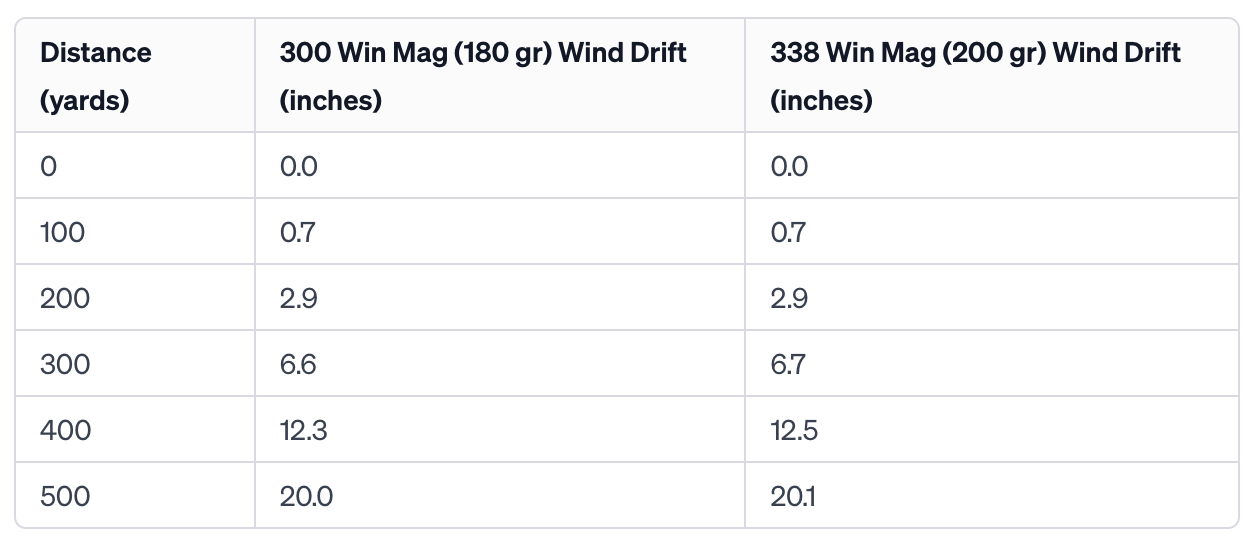
Recoil
- 300 Win Mag (180 gr): The 300 Win Mag has 35.08 ft-lbs of recoil, but it is less than the 338 Win Mag.
- 338 Win Mag (200 gr): Has 40.89 ft-lbs of recoil, which is 16.6% more recoil than the 300 Win Mag.

In conclusion, both the 300 Win Mag and the 338 Win Mag are outstanding choices for long-range shooting and hunting. The biggest benefit of the 338 Win Mag is that it can throw a 200-grain bullet the same as the 300 Win Mag can throw a 180-grain bullet. These cartridges are almost identical in many ways. You also get a large diameter hole with the 338 Win Mag since it is a bigger caliber. The question is – is the 16.6% more recoil worth the marginally better performance?
300 Win Mag vs 6.8 Western
The .300 Winchester Magnum (300 Win Mag) and the 6.8 Western are both intriguing choices for long-range shooters, but they serve different niches in the ballistic world. The 300 Win Mag is a well-established cartridge known for its versatility and power, while the 6.8 Western, a newer entrant, is gaining attention for its long-range capabilities and efficiency. Let’s compare these two cartridges across various ballistic aspects.
Velocity
- 300 Win Mag (180 gr): Maintains a high muzzle velocity, starting at approximately 2960 fps. At 500 yards it still has 1982 fps.
- 6.8 Western (175 gr): Offers basically the same muzzle velocity, 2970 fps, for a similar weighted 175 gr bullet. It also maintains its velocity better, at 500 yards it still maintains 2251 fps, a 269 fps difference.
Trajectory
- 300 Win Mag (180 gr): Has an almost identical bullet trajectory as the 6.8 Western. At 500 yards the 300 Win Mag has 41-inches of bullet drop.
- 6.8 Western (175 gr): At 500 yards, this cartridge has 40-inches of bullet drop, a difference of 1-inch, within 500 yards its tenths of inches.
Energy
- 300 Win Mag (180 gr): Has more energy within 175 yards. At the muzzle, it has 3502 ft-lbs of energy, 100 yards is 3013 ft-lbs, and at 200 yards has 2582 ft-lbs, this is the distance where the 6.8 Western starts to outperform the 300 Win Mag. Meaning it’s better suited for more power at closer distances.
- 6.8 Western (175 gr): At the muzzle it has 3226 ft-lbs (-276 ft-lbs), at 100 yards it has 2902 ft-lbs (-111 ft-lbs), and at 200 yards it has 2605 ft-lbs of energy (+23 ft-lbs). This means it’s a more optimal choice for more power at further distances.
Wind Drift
- 300 Win Mag (180 gr): Exhibits good resistance to wind drift, but not as good at the 6.8 Western. There is 20-inches of wind drift at 500 yards.
- 6.8 Western (175 gr): Its superior aerodynamic efficiency gives it an advantage in wind drift resistance. There is 14.2 inches of wind drift at 500 yards, edging out the 300 Win Mag with almost a 6-inch difference.

Recoil
- 300 Win Mag (180 gr): The 300 Win Mag has 35.08 ft-lbs of recoil, which is more than the 6.8 Western.
- 6.8 Western (175 gr): Offers less recoil of 32.52 ft-lbs, which is about 7.3% less recoil, which might be preferable for shooters looking for long-range capability with less kick.

In summary, the 300 Win Mag and the 6.8 Western both offer excellent long-range capabilities, but they cater to slightly different preferences in the shooting community. The 300 Win Mag provides the classic combination of power and precision, suitable for a wide range of hunting and long-range shooting applications. The 6.8 Western, with its focus on heavier, high-BC bullets and more moderate recoil, it’s an attractive option for shooters who prioritize long-range efficiency and comfort.
300 Win Mag vs 30 Nosler
When comparing the .300 Winchester Magnum (300 Win Mag) and the 30 Nosler, we are looking at two high-performing cartridges renowned for their long-range shooting capabilities. Using the specific data from our final tables, let’s dive into a detailed comparison of these two cartridges across key ballistic parameters.
Velocity
- 300 Win Mag (180 gr): The initial velocity of 2960 fps not as fast as the 30 Nosler, nor does it catch up or close the distance at any distance from 0-500 yards. It maintains about 250 fps slower speeds from 0-500 yards.
- 30 Nosler (180 gr): Has the fastest initial velocity of any cartridge in this comparison at 3200 fps. It’s also the fastest 30-caliber cartridge from 0 to 500 yards in this comparison. It also maintains its speed at distance better than the 300 Win Mag.
Bullet Trajectory
- 300 Win Mag (180 gr): Provides a flat trajectory, but not as flat as the 30 Nosler. At 500 yards it has 41-inches of drop.
- 30 Nosler (175 gr): Offers the second flattest trajectory of any cartridge in this comparison, just behind the 28 Nosler. It outperforms the 300 Win Mag at every range. At 500 yards it only has 32.5-inches of bullet drop, a difference of 8.5-inches.
Energy
- 300 Win Mag (180 gr): Delivers substantial energy, 3502 ft-lbs at the muzzle, and maintains its energy pretty well at distance with 1570 ft-lbs at 500 yards. Even so, it does not have nearly the same energy as the 30 Nosler. However, it does maintain its energy just as efficiently as the 30 Nosler, remaining a consistent +/- 550 ft-lbs less powerful from 0-500 yards.
- 30 Nosler (180 gr): The 30 Nosler, with its higher velocity, generates even greater energy, approximately 4092 ft-lbs at the muzzle, a 590 ft-lbs difference. At 500 yards it still maintains a solid 2105 ft-lbs, a 535 ft-lbs difference.
Wind Drift
- 300 Win Mag (180 gr): Does well in the wind, but not as good as the 28 Nosler. At 500 yards it has 20-inches of wind drift.
- 30 Nosler (180 gr): It outperforms the 300 Win Mag at every range but not by a lot. At 500 yards it only has 14.2-inches of drift, a difference of 5.8-inches.

Recoil
- 300 Win Mag (180 gr): The 300 Win Mag has 35.08 ft-lbs of recoil, which is significant, but not as bad as the 30 Nosler.
- 30 Nosler (180 gr): Its powerful performance comes with the trade-off of increased kickback (41.48 ft-lbs), 18.3% more than the 300 Win Mag, requiring good recoil management for optimal shooting.

In conclusion, both the 300 Win Mag and the 30 Nosler are exceptional cartridges for long-range shooting, each excelling in different areas. The 300 Win Mag is a proven, versatile cartridge offering excellent all-around performance. In contrast, the 30 Nosler, with its higher velocity and energy, might be the better choice for shooters seeking maximum performance at extended ranges, especially in windy conditions. However, this comes with the trade-off of increased recoil.
300 Win Mag vs 7mm PRC
The .300 Winchester Magnum (300 Win Mag) and the 7mm Precision Rifle Cartridge (7mm PRC) are two impressive cartridges in the realm of long-range shooting, each with its own set of strengths. While the 300 Win Mag has a long-standing reputation for power and versatility, the 7mm PRC is a newer entry known for its efficiency and long-range capabilities. Let’s compare these cartridges based on our detailed ballistic tables.
Velocity
- 300 Win Mag (180 gr): This cartridge showcases a muzzle velocity of approximately 2960 fps, which is very similar to the 7mm PRC. Things change fast after the muzzle, though, the 7 PRC is much more efficient and retains its speed better across all ranges, pulling far ahead of the 300 Win Mag. At 500 yards the 300 Win Mag is at 1982 fps.
- 7mm PRC (175 gr): Offers a slightly faster 3000 fps velocity than the 300 Win Mag at the muzzle with 3000 fps. But it is much more efficient, quickly pulling away from the 300 Win Mag at a distance. At 500 yards it still maintains 2345 fps, a 363 fps difference. This is the second fastest cartridge in this comparison at long-distance shooting, just behind the 28 Nosler at 500 yards.
Trajectory
- 300 Win Mag (180 gr): Does not have as flat of a trajectory as the 7 PRC, but it’s not too far off. At 500 yards there are 41-inches of drop.
- 7mm PRC (175 gr): Also provides a relatively flat trajectory, benefiting from efficient bullet design. At 500 yards there are 34.1-inches drop, a difference of 6.9-inches.
Energy
- 300 Win Mag (180 gr): The muzzle energy is 3502 ft-lbs which is almost identical to the 7 PRC at the muzzle. At 500 yards the 300 Win Mag has 1570 ft-lbs of energy which is much less energy than the 7 PRC.
- 7mm PRC (175 gr): As stated, the muzzle energy is almost identical at 3497 ft-lbs, a 5 ft-lbs difference. It immediately pulls away from the 300 Win Mag, maintaining much more energy downrange. At 500 yards the 7mm PRC has 2137 ft-lbs of energy, a difference of 567 ft-lbs which is substantial.
Wind Drift
- 300 Win Mag (180 gr): Does well in the wind, but not nearly as good as that efficient 7 PRC. At 500 yards it has 20-inches of wind drift.
- 7mm PRC (175 gr): This cartridge has the least wind drift of any cartridge in this comparison, coming in at 11.5-inches of drift at 500 yards, almost half of the 300 Win Mag! Resulting in 8.5-inches less wind drift at 500 yards.

Recoil
- 300 Win Mag (180 gr): The 300 Win Mag has 35.08 ft-lbs of recoil, it has about the same but just a little more than the 7mm PRC.
- 7mm PRC (175 gr): This cartridge has 34.41 ft-lbs of recoil, only a 1.9% difference. The recoil is almost identical to the 300 Win Mag, you wouldn’t even notice a difference between the two cartridges.

In summary, the 7mm PRC is a better, more efficient cartridge in every way than the 300 Win Mag. The 7 PRC has better velocity, trajectory, energy, wind drift, and recoil than the 300 Win Mag. The benefits of the 7 PRC feel almost exponential past the muzzle compared to the 300 Win Mag.
300 Win Mag vs 300 WSM
The .300 Winchester Magnum (300 Win Mag) and the .300 Winchester Short Magnum (300 WSM) are both highly respected cartridges in the world of long-range shooting, each offering distinct advantages. While the 300 Win Mag is renowned for its long-range capabilities and versatility, the 300 WSM is known for its efficiency and shorter action design. Let’s delve into a comprehensive comparison of these two 30-caliber cartridges.
Velocity
- 300 Win Mag (180 gr): Boasts a higher muzzle velocity of around 2960 fps, but is using a lighter 180 gr bullet. The 300 Win Mag is faster to about 250 yards, then the 300 WSM takes the lead. At 500 yards the 300 Win Mag maintains 1982 fps.
- 300 WSM (200 gr): Offers a solid 2810 fps at the muzzle for a 200 gr bullet. While this is slower at first, at about 250 yards the 300 WSM has more velocity and maintains increasingly better velocity out to 500 yards. At 500 yards the 300 WSM maintains 2105 fps, so only a marginal 123 fps difference.
Trajectory
- 300 Win Mag (180 gr) and 300 WSM (200 gr): The 180 gr 300 Win Mag and the 200 gr 300 WSM have almost identical bullet trajectories. You won’t notice a difference between these two cartridges. They both have about 41-inches of bullet drop at 500 yards.
Energy
- 300 Win Mag (180 gr): Has 3502 ft-lbs at the muzzle, which is basically the same as the 300 WSM, but the more efficient 300 WSM retains energy better and has significantly more energy at 500 yards. At 500 yards the 300 Win Mag has 1570 ft-lbs.
- 300 WSM (200 gr): Has 3506 ft-lbs of energy at the muzzle, almost identical to the 300 Win Mag. However, it outperforms the 300 Win Mag at every other distance from +/- 25-500 yards. At 500 yards the 300 WSM has 1967 ft-lbs of energy, a 397 ft-lbs difference.
Wind Drift
- 300 Win Mag (180 gr): Does not perform as well as the 300 WSM, there is more drift with this cartridge. At 500 yards there is 20-inches of drift.
- 300 WSM (200 gr): Performs better overall, at 500 yards there is only 14.8-inches of drop, a 5.2-inch difference.

Recoil
- 300 Win Mag (180 gr): The 300 Win Mag has 35.08 ft-lbs of recoil, which is slightly less than the 300 WSM but not by much. You won’t be able to tell the difference.
- 300 WSM (200 gr): This cartridge has 35.61 ft-lbs of recoil, almost identical to the 300 Win Mag (only 1.5% more recoil). But remember, this is a heavier grain bullet.

In summary, while both the 300 Win Mag and the 300 WSM offer exceptional long-range capabilities, they cater to slightly different preferences and needs in the shooting community. The 300 Win Mag provides classic, tried-and-true performance with excellent all-around ballistic characteristics. In contrast, the 300 WSM, with its compact design and comparable performance, still outperforms the 300 Win Mag. This makes it an attractive option for those who prefer a shorter-action rifle without compromising on power and range.
Final Thoughts
If you liked this article you might also like:
